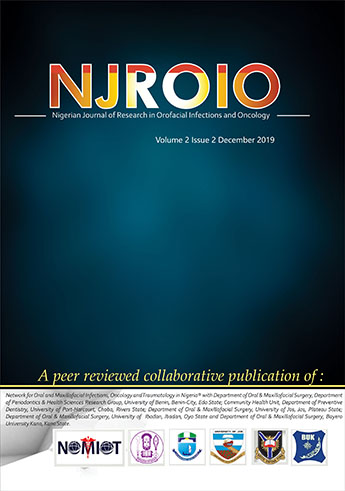
Volume 1 Issue 1 & 2
June 20, 2019
Volume 2 Issue 2
November 8, 2019CONTENT
Are Gram Negative Microbes Producing Odoriferous Compounds Friends or Foes to Humans?
Gram negative microorganisms produce volatile sulphur compounds widely implicated in the production of malodour and destruction of various human tissues. However, the volatile sulphur compounds have also been found to be beneficial in the regulation of many processes in the human system. It is important to have a good knowledge of the effect the volatile sulphur compounds on human tissues, especially since a number of treatment protocols for the management of oral malodour have been hinged on the reduction in the concentration of these odoriferous gases. This review is therefore to outline how much of a friend or foe the odoriferous volatile sulphur compounds, produced by oral microbials, are to humans.
Median Rhomboid Glossitis: Co-Infection by Candida albicans and Staphylococcus aureus (Case Report)
Median rhomboid glossitis is a disorder of the tongue thought to be induced by Candida species. It is seen as an ovoid or rhomboid area of erythema on the posterior aspect of the dorsum of the tongue. Most cases are asymptomatic and the condition is innocuous. However, the striking erythematous appearance may be a cause for alarm to the patient. As such, clinicians need to be familiar with this condition. We report a case of median rhomboid glossitis due to co-infection by Candida albicans and Staphylococcus aureus and propose that such co-infection may be responsible for incomplete resolution of some cases of median rhomboid glossitis following treatment.
Awareness of the Causes and Prevention of Dental Caries among Dental Outpatients in Central Hospital Benin City, Nigeria
Objective: To determine the awareness of the causes and prevention of dental caries among dental outpatients in Central Hospital, Benin City. Methods: This study was a cross-sectional study carried out in Dental Centre of Central Hospital, Benin City. A total of 194 participants (18 years and above) attending the clinic during the four weeks study period participated in the study. An informed consent was obtained from the respondents following which a questionnaire was administered by a research assistant. Data was collected on their socio-demographic characteristics, awareness of dental caries and their causes and prevention.
Results: A total of 166 (85.6%) of the respondents reported awareness of dental caries. Those that were aware, their major (77.2%) source of information was human (relatives, friends and colleagues and so on). The majority (60.8%) thought that worm was the cause of dental caries and only 38.6% knew the actual cause of dental caries. The respondents that were aware of prevention of dental caries were 83.1% and 79.3% knew the correct method of preventing it.
Conclusion: The awareness about dental caries and its prevention was high but the awareness about the actual cause is low as many of the respondents still believed in the ancient theory that dental caries is caused by tooth worm.

